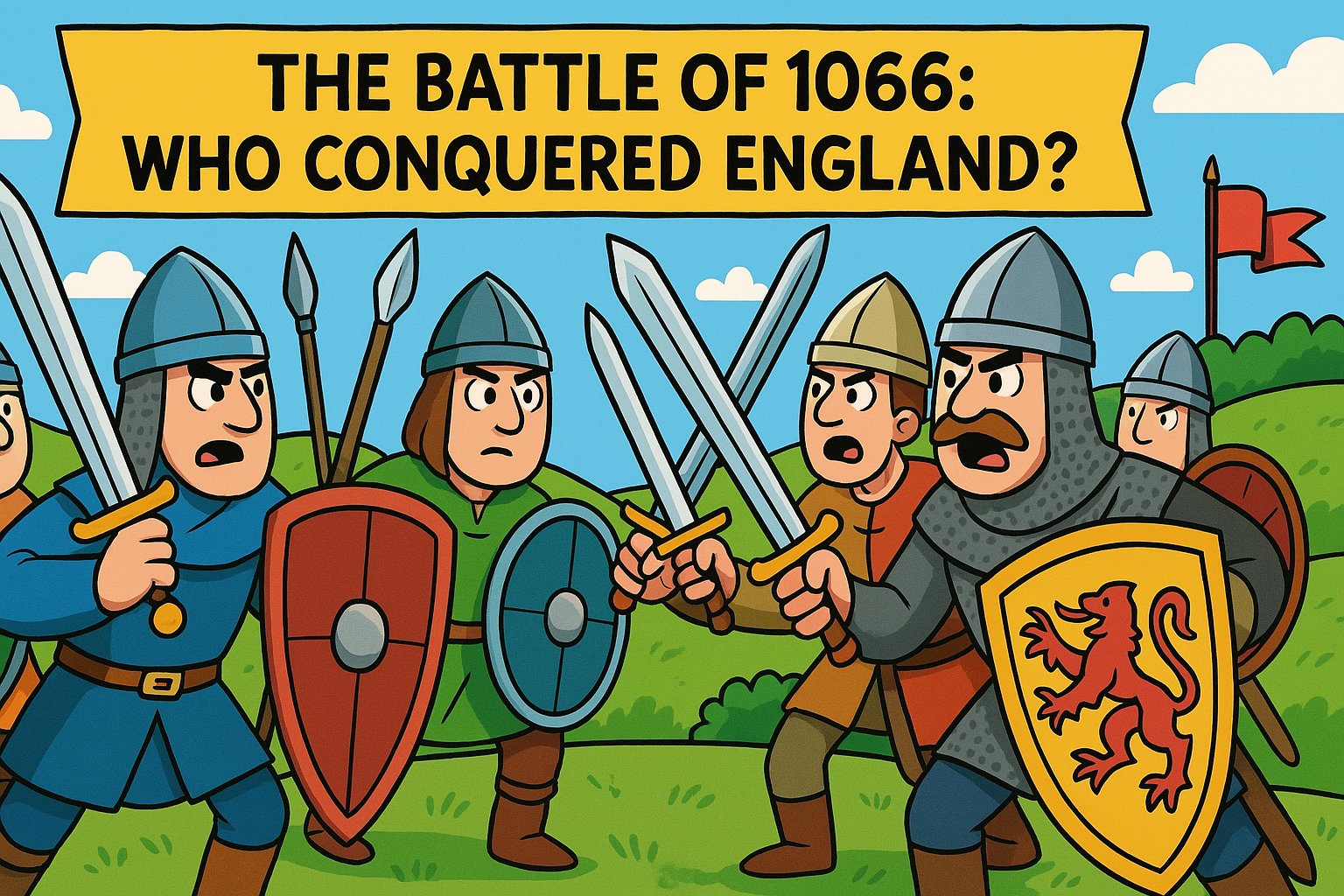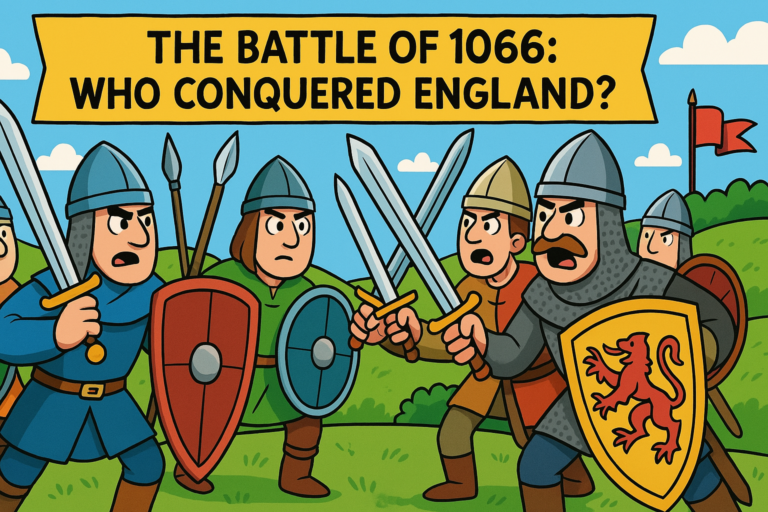The Battle of 1066: Who Conquered England?
The Battle of 1066: Who Conquered England?
The Battle of 1066: Who Conquered England? is one of the most famous events in British history. In a single year, three different rulers claimed the English crown, leading to fierce battles and a dramatic outcome. It all ended with the famous Battle of Hastings — a moment that completely changed who ruled the country.
Understanding who conquered England in 1066 helps explain how our language, culture, and laws were shaped. Let’s find out who won the fight, how they did it, and why it still matters today.
This topic is part of our Info Zone collection. You can read the full topic, once logged in, here: The Battle of 1066: Who Conquered England?
You’ll also find a full Lesson Plan and a handy Parent Q & A sheet, for this topic, ready to use..
The Battle of Hastings: Who Conquered England and Why It Mattered
When King Edward the Confessor died early in 1066, he left no children. That meant no one had a clear right to the throne. Three powerful leaders quickly stepped forward, each determined to be the next King of England.
The struggle between them led to not just one, but three major battles — and the most famous of them all was the Battle of Hastings. Only one would conquer England and change its future forever.
Who Wanted to Be King of England?
In 1066, there were three main claimants to the throne of England. Each of them believed they had a strong reason to rule.
Harold Godwinson was the Earl of Wessex and the most powerful man in England. He claimed that King Edward had promised him the crown on his deathbed. The English nobles supported Harold, and he was crowned almost immediately.
William, Duke of Normandy, said that Edward had once promised the throne to him instead. William also claimed that Harold had sworn a holy oath to support him — a promise Harold later broke.
Harald Hardrada, the King of Norway, believed that an earlier agreement gave him the right to rule. He came to England with a massive Viking army, determined to take the crown by force.
England Before the Battle of 1066
Before the battle, England was a wealthy and stable kingdom. It had been ruled by Anglo-Saxon kings for hundreds of years. The people mostly lived in small farming villages, and their lives were controlled by local lords.
There wasn’t a full-time army. Instead, landowners were expected to raise fighters when needed. This meant that speed and timing were vital in any war — and in 1066, that would prove very important.
Without a clear heir to the throne, England became a tempting prize. It was now at risk of invasion from both the north and the south.
The Viking Invasion: Fulford and Stamford Bridge
Harald Hardrada was the first to make a move. He arrived from Norway with hundreds of ships and joined forces with Tostig, Harold’s angry brother. On 20 September, they defeated an English army at the Battle of Fulford, near York.
Just five days later, Harold Godwinson responded. He marched his army from London to Yorkshire in just four days — an incredible feat. At the Battle of Stamford Bridge on 25 September, he launched a surprise attack and defeated the Viking invaders.
Harald Hardrada and Tostig were both killed. The Viking threat was over, but Harold’s men were exhausted — and a new danger had just arrived on the southern coast.
William of Normandy Arrives in England
While Harold was up north, William landed his army in Sussex on 28 September. His soldiers quickly built a wooden castle and began raiding nearby villages. He was ready for war.
Harold heard the news and immediately turned his army around. In less than two weeks, he marched all the way back south. His tired army faced fresh Norman troops who had spent weeks preparing.
The final showdown would take place near Hastings on 14 October. It would decide once and for all who conquered England in 1066.
Battle of Hastings: A Fight for the Crown
Harold’s forces took position on a hill, forming a shield wall — a strong line of men standing shoulder to shoulder, shields touching. This made it very hard for the enemy to break through.
William’s army was made up of knights, archers, and foot soldiers. They attacked from below, but the shield wall held firm. Again and again, Norman soldiers were pushed back.
However, when some Norman troops pretended to flee, English soldiers chased them — breaking their formation. William used this trick to weaken the shield wall further.
The Turning Point: Harold Falls in Battle
Late in the afternoon, something happened that changed everything. Harold was killed — either by an arrow to the eye or in hand-to-hand fighting. With their leader gone, the English began to panic and flee.
William’s men chased the remaining soldiers and crushed them. By the end of the day, the Normans had won. William had conquered England through determination, skill, and clever strategy.
His victory at Hastings became one of the most important moments in British history.
After the Battle: A New King of England
William didn’t become king immediately. First, he had to secure control. He marched towards London, defeating rebels along the way.
On Christmas Day 1066, William was crowned King of England at Westminster Abbey. He became known as William the Conqueror.
Over the next few years, he built castles across the country to maintain power. He also introduced many new laws and systems of control.
How the Norman Conquest Changed England
William replaced most English nobles with Norman ones. These new rulers spoke French, brought new customs, and changed the way land was owned and managed.
The English language began to change too. Words like “court,” “judge,” and “government” came from Norman French.
In 1086, William ordered the Domesday Book to be written — a record of who owned what land. It helped him control the kingdom and collect taxes fairly.
Why 1066 Still Matters Today
The events of 1066 shaped modern Britain in many ways. Our government, legal system, and even the way we speak were influenced by what happened that year.
The Battle of 1066: Who Conquered England? is still a key part of history lessons today because it explains why England changed so dramatically.
From castles to courts, the marks left by William and the Normans are still visible all around us.
What Do You Remember?
- Who were the three claimants to the English throne in 1066?
- What was the shield wall, and how did it help the English army?
- Why did William’s troops pretend to run away?
- What happened to Harold during the Battle of Hastings?
- How did the Norman Conquest change England?
Write your answers in the comment section below.
Related Topics
If you found this story exciting, try exploring more about the Normans, Anglo-Saxons, and Viking invaders. You can also look at the Bayeux Tapestry, which shows the Battle of Hastings in pictures.
What Do You Think?
If you found this to be an interesting topic, why not have your say. Or if you can think of ways we could improve it. We would love to know what you learned and more importantly, what you think. So now is your chance, use the comments section below to let us know your thoughts.
Members Only
You need to be registered and logged in to access this learning resource and other member only content. It only costs £1.99

